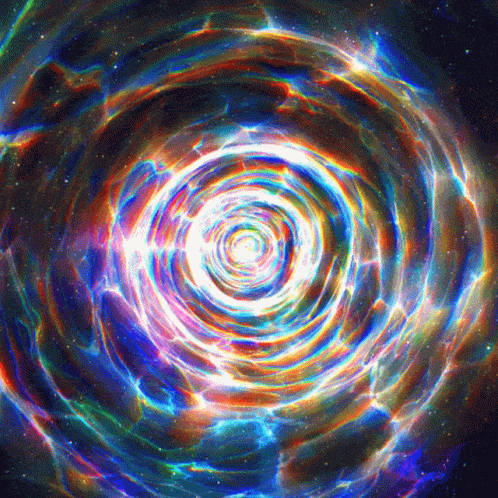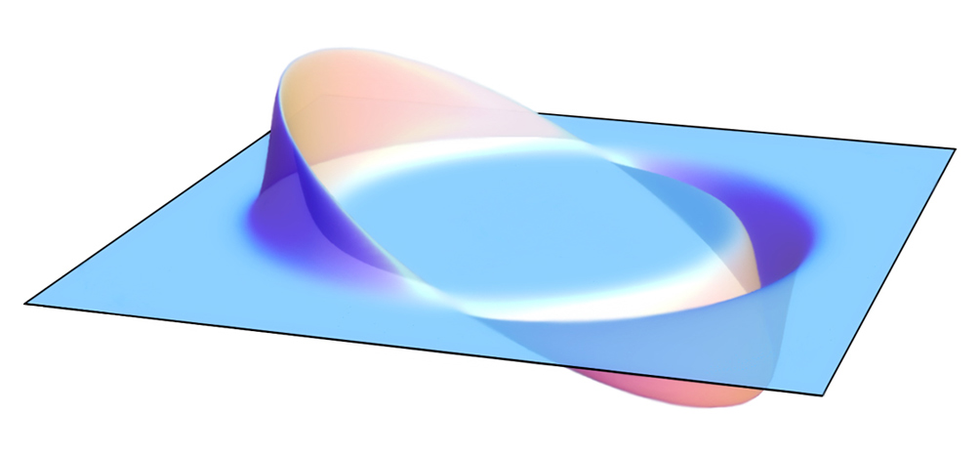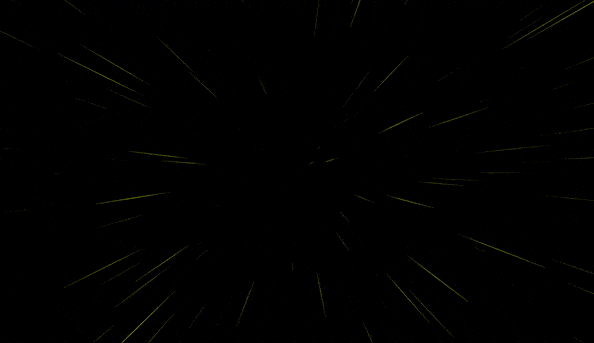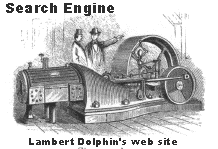Lambert Dolphin, Physicist

Lambert Dolphin, Physicist

 Superman was able to leap tall buildings
in a single bound, he was more powerful than a locomotive, and
was said to be able to travel faster than a speeding bullet.
Superman was able to leap tall buildings
in a single bound, he was more powerful than a locomotive, and
was said to be able to travel faster than a speeding bullet.
The speed of a bullet (300-900 m/sec) is no big deal in these days of supersonic aircraft and spacecraft. Yet our fastest space vehicles do no better than one one-hundred thousandth (1:10-5) of the current speed of light. Overcoming gravity (the weakest of all the forces of physics) still takes lots of push and power. The moon remains many days away and the planets many months when traveling as fast as current chemical rocket technology allows.
The nearest star is 4 x 1017 meters away, and the current estimated size for the entire universe is greater than that by ten orders of magnitude or so (about 1026 meters). For a long time the hope of space travel has been left almost entirely in the hands of the science fiction writers. Yet with God there are invariably hidden truths waiting to be discovered that make the best that men can imagine seem like kindergarten.
Newtonian mechanics imposes no maximum upper limit to attainable velocities in the universe, but Einstein's relativity theory does. As charged particles are pushed up near the present speed of light they grow heavier and more and more energy input is required to gain a smaller and smaller increment of increased velocity. At the Stanford Linear Accelerator (SLAC), near where I live, electrons injected in the accelerator reach 99.999% of the velocity of light in the first few feet of travel, and then they ride traveling radio waves for two miles down a long evacuated pipe, gaining virtually no additional speed, but mostly acquiring mass (and therefore energy). There is no reason to doubt the highly successful and well-verified theory of relativity in this regard. One can point to countless examples of proven relativistic effects whenever charged particles are involved.
Physicist Hal Puthoff (1) has recently suggested that the ability of a spacecraft to modify the properties of space in its immediate vicinity could allow it to travel faster than light. This is because the speed of light is simply a measure of two properties of the medium of space, or the vacuum, permeability and permittivity. It has been tacitly assumed by some theoreticians that the speed of light might be a measure not only of the electrical properties of space, but also the mechanical properties of space as well. It turns out now that this is probably not the case!
An even very exciting possibility has now come into the light. It has long been known that gravitational forces apparently act instantaneously over the entire universe. Why this should be so is simply glossed over and ignored in every generation of physics classes and in countless technical papers. One way to understand this is to consider what is called "the classical aberration of light"--which was discovered by Bradley in 1728. In fact, aberration data became one of the early methods for measuring the speed of light. Light from the sun requires 8.3 minutes to travel from the sun to the earth during which time the sun and the earth have moved as much as 20 arc seconds with respect to each other. Similarly light from the stars arrives at an angle which can be as much as 20 arc seconds because the earth is moving with respect to the stars. It is by carefully measuring these aberration angles, and knowing the relatively velocities involved, that Bradley made excellent and trustworthy measurements of the velocity of light 250 years ago.
However, during the time interval it takes light to travel from the sun to the earth, the sun and the earth have kept in touch with each other "instantaneously"--or at least very much faster than c! In fact every mass in the universe communicates with all other masses in the universe in a time frame that makes the present speed of light seem like the velocity of molasses on a cold day!
Astronomer Tom Flandern has recently detailed all the evidence that shows that gravitational forces, unlike light, operate with no measurable aberration! (2) But Van Flandern shows that there are sound reasons for believing that the "speed of gravity" is not infinite. By carefully studying the observable data Van Flandern now concludes that the speed of gravity is greater than or equal to the present speed of light by a factor of 2 x 1010. This velocity (6 x 1018 meters per second) turns out to be just below Barry Setterfield's latest estimate of the speed of light everywhere in the universe on Day Two of creation week! Setterfield arrives at this initial velocity of light on the basis of the maximum observed Hubble constant which gives an initial value of c turns out to be 2.54 x 1010 times the present value. (3) Since creation week the diameter of the universe has been constant (a static universe) and the speed of light has dropped precipitously to its present value--following decay curves we can now piece together with some confidence based on (a) measured values of c for the last 300 years, (b) corrections to known radioactive decay dates which go back to approximately 2000 BC, and (c) the observed quantization of the red shift of light from distant galaxies for the time period from creation to about the time of Abraham.
As the universe aged, the free space permittivity and permeability increased and c decreased--but the velocity of gravity may not be tied to the permittivity and permeability of free space! If this the case the velocity of gravity stayed at the original velocity of c. If we can produce a propulsion system based on gravitational principles rather than electromagnetic or chemical ones, we could travel at absolutely enormous speeds--we could hope to push a space craft anywhere in the universe, very literally at warp speeds beyond what even the Starship Enterprise could produce!
By the way, this discussion solely relates to the physical part of the created universe. For now we must defer discussion about how angels travel and communicate--they are spiritual beings. And we must postpone speculation about what we followers of Jesus the Lord may find ourselves capable of doing when we don our new resurrection bodies (these bodies are, after all, "not of this creation"--but spiritual bodies--see 1 Corinthians 15).
If Van Flandern and Setterfield are correct, space travel may indeed be just around the corner! A fringe benefit is that we may at last have clues to help us begin to understand the well-documented behavior of countless UFOs whose velocity and acceleration behavior has thus far defied explanation by conventional physics.
Notes:
1. JSE Review by H. E. Puthoff, Ph.D., Institute for Advanced Studies at Austin, Austin, TX 78759. Available on my web pages, http://www.ldolphin.org/hill.html. Putoff reviews the book Synopsis of Unconventional Flying Objects, by Paul Hill, Hampton Roads Publ. Co., Charlottesville, VA, 1995 (ISBN 1-57174-027-9). The latter is an excellent if somewhat outdated analysis of possible UFO propulsion schemes by a retired a Chief Scientist-Manager at NASA's Langley Research Center.
2. Tom Van Flandern, The Speed of Gravity: What the Experiments Say, Meta Research Bulletin, Vol. 6. No. 4, December 15, 1997. See http://www.metaresearch.org.
3. Barry Setterfield, Box 318, Blackwood 5051 SA, Australia, private communication., 1/7/98. (Setterfield's recent report Creation and Catastrophe is available from Koinonia House, http://www.khouse.org). Technical notes on the speed of gravity, speed of light and ZPE.
4. See also "What is Light,"
for a discussion on the nature of physical and spiritual light.
5. Constancy of the Speed of Light
information pages.
6. What Holds the Universe Together?
Revised and corrected, March 13, 1998.
Reviewed by phone with Barry Setterfield.
Added November 8, 2022

Up until this point, scientists have slowly chipped away at the fantasy of faster-than-light (FTL) travel by relying on theories of bizarre physics and exotic matter. But in a new paper, Göttingen University’s Erik Lentz has created a theoretical design of a warp drive that’s actually grounded in conventional physics. Lentz’s theory overcomes the need for a source of exotic matter in previous designs by reimagining the shape of warped space.
To put this into context, we’ll catch you up to (warp) speed. The colloquial term “warp drive” comes from science fiction, most famously Star Trek. The Federation’s FTL warp drive works by colliding matter and antimatter and converting the explosive energy to propulsion. Star Trek suggests this extraordinary power alone pushes the ship at FTL speeds.
The concept of a warp drive is so tantalizing simply because space is really, really big. It would take a modern, chemically burning rocket more than 100,000 years to travel to Alpha Centauri, our nearest star system. Even if we traveled at the speed of light—which is conventionally impossible—a one-way voyage would still take four years. Without warp drive, we’re probably never making it to a neighboring star system.
Our current understanding of warp speed dates back to 1994, when a now-iconic theoretical physicist named Miguel Alcubierre first proposed what we’ve called the Alcubierre drive ever since. The Alcubierre drive conforms to Einstein’s theory of general relativity to achieve superluminal travel.
“By a purely local expansion of spacetime behind the spaceship and an opposite contraction in front of it,” Alcubierre wrote in his paper’s abstract, “motion faster than the speed of light as seen by observers outside the disturbed region is possible.”

2D visualization of an Alcubierre drive.
AllenMcC/Creative CommonsEssentially, an Alcubierre drive would expend a tremendous amount of energy—likely more than what’s available within the universe—to contract and twist space-time in front of it and create a bubble. Inside that bubble would be an inertial reference frame where explorers would feel no proper acceleration. The rules of physics would still apply within the bubble, but the ship would be localized outside of space.
Alcubierre’s idea rests on expending stupendous amounts of energy to create a bubble of exotic matter—in this case, negative energy. The problem? There’s no mechanism known to particle physics capable of creating this negative energy.
This telescope features a 70mm aperture and comes with fully coated optimal lenses to offer a crisp, clear view of the night's sky. Tech-savvy stargazers will appreciate the smart phone adapter and wireless camera remote, making it possible to view constellations from your screen.
All you need to do is point the tube in the direction of the desired object and take a gander. With two high-quality eyepieces (70mm and 360mm) that provide low- and high-power views of celestial objects, you'll be able to satisfy your stargazing wishes with ease.
This option features a wide, 70-millimeter aperture that will make stars and constellations appear bright and clear. It also has a smartphone adapter so you can view everything directly from your screen.
Using this telescope is easy: All you need to do is point the tube in the direction of the desired object and take a gander. Two eyepieces make it possible to easily score a wide or narrow view of the sky.
That leads us to Lentz’s paper, which appears in the new issue of the peer-reviewed journal Classical and Quantum Gravity. In it, Lentz reveals a new method of creating a warp drive using conventional physics and without the need for undiscovered forms of exotic matter. After studying existing research on warp drives, Lentz realized there were specific forms of spacetime bubbles that scientists had overlooked. These bubbles took the shape of solitons, or compact waves that maintain their whip while moving at constant velocity. (Think of a single ripple steadily moving across a calm lake.) Lentz rederived Einstein’s equations for different soliton configurations until he found one that worked with conventional energy sources and without the need for any exotic matter.
“This work has moved the problem of faster-than-light travel one step away from theoretical research in fundamental physics and closer to engineering,” Lentz said in a statement:
“The next step is to figure out how to bring down the astronomical amount of energy needed to within the range of today’s technologies, such as a large modern nuclear fission power plant. Then we can talk about building the first prototypes.”
Lentz’s warp bubble still doesn’t overcome one of the biggest hurdles of FTL travel: the immense amount of energy required to warp spacetime.
Creating a warp bubble for a 656-foot-wide spacecraft traveling at the speed of light requires roughly 100 times the energy contained in the mass of Jupiter, said Lentz. That’s about 30 orders of magnitude higher than the power of modern nuclear reactors. “Fortunately, several energy-saving mechanisms have been proposed in earlier research that can potentially lower the energy required by nearly 60 orders of magnitude,” he said.
In the meantime, Lentz believes the plasmas surrounding extremely magnetic neutron stars may be a natural place to look for the signatures of positive-energy solitons.
Elsewhere in the world of warp drive, scientists in the Advanced Propulsion Lab (APL) at Applied Physics just published the world’s first model for a physical warp drive in Classical and Quantum Gravity. Like Lentz’s research, this model also flies in the face of what we’ve long thought about warp speed travel: that it requires exotic, negative forces.
Where the existing paradigm uses negative energy, the APL concept also uses floating bubbles of spacetime rather than floating shipsin spacetime. Though Alcubierre himself has endorsed this model, the concept is still very much in the “far future” zone of possibility, made of ideas that scientists still don’t know how to construct in any sense. The APL scientists write:
“While the mass requirements needed for such modifications are still enormous at present, our work suggests a method of constructing such objects based on fully understood laws of physics.”
Let’s hope the “far future” isn’t as far as it sounds. If scientists keep achieving warp drive breakthroughs, that might be the case.

Lambert Dolphin's Place
Lambert's Personal Testimony
Archive for Newsletters
Library Annex (since 2018)
Music for today
Jesus, The Light of the World
Pachelbel: Canon in D
 Email Lambert Dolphin
Email Lambert Dolphin
March 13, 1998. November 7, 2022.
